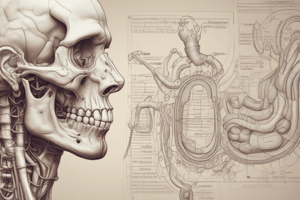Podcast
Questions and Answers
What are the functions of the liver?
What are the functions of the liver?
- Digestive, reproductive, lymphatic, and nervous functions
- Digestive, endocrine, skeletal, and muscular functions
- Digestive, circulatory, respiratory, and excretory functions
- Digestive, metabolic, hematologic, vascular, and immunologic functions (correct)
What is the main function of hepatocytes?
What is the main function of hepatocytes?
- Synthesizing bile (correct)
- Forming bile salts
- Conjugating primary bile acids
- Destroying microorganisms
Which vessels form the hepatic portal vein?
Which vessels form the hepatic portal vein?
- Inferior mesenteric and gastric veins
- Coronary and falciform ligaments
- Hepatic and cystic veins
- Superior mesenteric and splenic veins (correct)
Where does the bile drain into before entering the duodenum?
Where does the bile drain into before entering the duodenum?
What is the function of Kupffer cells in the liver?
What is the function of Kupffer cells in the liver?
What is the source of blood for the sinusoids in the liver?
What is the source of blood for the sinusoids in the liver?
How are primary bile acids synthesized in the liver?
How are primary bile acids synthesized in the liver?
Which of the following is true about bile salts and acids?
Which of the following is true about bile salts and acids?
What is the function of the gallbladder?
What is the function of the gallbladder?
What stimulates the pancreatic secretion of alkaline fluid?
What stimulates the pancreatic secretion of alkaline fluid?
What is the primary function of the endocrine pancreas?
What is the primary function of the endocrine pancreas?
What happens to unconjugated bilirubin in the liver?
What happens to unconjugated bilirubin in the liver?
What is the primary function of the liver in fat metabolism?
What is the primary function of the liver in fat metabolism?
Where does the majority of fat absorption occur?
Where does the majority of fat absorption occur?
What is the primary function of the liver in protein metabolism?
What is the primary function of the liver in protein metabolism?
Flashcards are hidden until you start studying
Study Notes
Functions of the Liver
- Major metabolic processes including detoxification, protein synthesis, and the production of biochemicals necessary for digestion.
- Regulates blood glucose levels by converting excess glucose to glycogen.
- Synthesizes bile acids that are crucial for fat digestion and absorption.
Main Function of Hepatocytes
- Hepatocytes are responsible for metabolic activities and produce proteins essential for blood clotting and immune function.
Formation of the Hepatic Portal Vein
- The hepatic portal vein is formed by the confluence of the superior mesenteric vein and the splenic vein.
Drainage of Bile
- Bile drains into the bile ducts that merge into the common bile duct before entering the duodenum.
Function of Kupffer Cells
- Kupffer cells are specialized macrophages in the liver playing a key role in immune response through phagocytosis of pathogens and dead cells.
Source of Blood for Sinusoids
- Sinusoids in the liver receive blood from the hepatic artery and the portal vein, facilitating nutrient and waste exchange.
Synthesis of Primary Bile Acids
- Primary bile acids are synthesized in hepatocytes from cholesterol through enzymatic reactions.
Bile Salts and Acids
- Bile acids are derived from cholesterol, while bile salts are the conjugated form of bile acids that aid in emulsifying fats for digestion.
Function of the Gallbladder
- The gallbladder stores and concentrates bile, releasing it into the duodenum to aid in fat digestion.
Stimulation of Pancreatic Secretion
- Pancreatic secretion of alkaline fluid is stimulated by the hormone secretin in response to acidic chyme entering the duodenum.
Primary Function of the Endocrine Pancreas
- The primary function includes regulation of blood sugar levels through the secretion of insulin and glucagon.
Unconjugated Bilirubin in the Liver
- Unconjugated bilirubin is converted to conjugated bilirubin in the liver, making it water-soluble for excretion.
Liver's Role in Fat Metabolism
- The liver synthesizes and metabolizes fats, produces ketone bodies, and regulates lipid levels in the bloodstream.
Majority of Fat Absorption
- Most fat absorption occurs in the small intestine, specifically in the jejunum.
Liver's Role in Protein Metabolism
- The liver is involved in the synthesis of plasma proteins, including albumin and clotting factors, and ammonia conversion to urea for excretion.
Studying That Suits You
Use AI to generate personalized quizzes and flashcards to suit your learning preferences.




